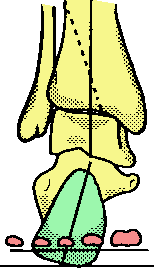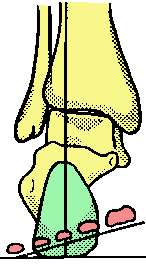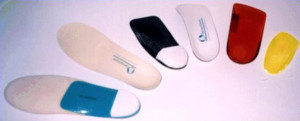Biomechanics
Biomechanics
“Podiatric Biomechanics” refers to the study and the application of mechanical principles to the lower limb. To put it more simply, if a patients’ legs and/or feet are “out of line”, this can cause problems in the lower limb and back. Although this type of problem occurs most in people who are very active (such as sports people), or who are on their feet a lot (such as hairdressers or policeman), it can affect anyone if their feet are far enough out of line, or alternatively as people get older and their bodies are less able to cope with mechanical imperfections.

 In a “perfect” foot, the heel should be at right angles to the ground, the leg also at right angles to the ground (and therefore parallel to the heel), and the forefoot (or ball of the foot) flat against the ground, as shown by the pictures on the right (leg=yellow, heel=green, forefoot=pink). Feet which are in this position work efficiently and are unlikely to cause any symptoms.
In a “perfect” foot, the heel should be at right angles to the ground, the leg also at right angles to the ground (and therefore parallel to the heel), and the forefoot (or ball of the foot) flat against the ground, as shown by the pictures on the right (leg=yellow, heel=green, forefoot=pink). Feet which are in this position work efficiently and are unlikely to cause any symptoms.
Problems can be caused by any one part of the foot being misaligned (see above). In this example, the forefoot is tilted slightly to the inside as it hits the ground (see picture on left). As it is difficult to walk like this, most people “compensate” by rocking the heel outwards in the other direction in order to bring the big toe into contact ith the ground so that they can “push off” easily at the end of the step. This means that the heel is forced to work in an inefficient position (see right hand picture), which puts the whole body out of alignment placing excessive stress on other structures, which may then develop symptoms. These symptoms often include arch pain (plantar fasciatis), knee pain (common in runners), shin splints, hallux valgus (bunions), ankle ligament weakness, and even lower back pain (to name just a few!). Bear in mind that these misalignments may only be a matter of three or four degrees, but many overuse sports injuries are caused by biomechanical problems which are exacerbated if, for instance, you run thirty miles a week on a misaligned foot.
 Fortunately, help is at hand in the form of devices called orthotics (see above picture). Although these look like simple arch supports, they are highly accurately made foot plates which correct any biomechanical problems in the foot or leg. They are made by taking a series of measurements from the feet and legs of the patient in addition to plaster cast impressions of the feet. The orthotics are actually made on the plaster cast moulds of the feet so as to fit closely against the foot, and are banked to compensate for the misalignments which the foot is measured to have – for instance, if a foot is tilted inwards at six degrees, the orthotic will be banked at a six degree angle to “wedge up” the foot where it is imbalanced.
Fortunately, help is at hand in the form of devices called orthotics (see above picture). Although these look like simple arch supports, they are highly accurately made foot plates which correct any biomechanical problems in the foot or leg. They are made by taking a series of measurements from the feet and legs of the patient in addition to plaster cast impressions of the feet. The orthotics are actually made on the plaster cast moulds of the feet so as to fit closely against the foot, and are banked to compensate for the misalignments which the foot is measured to have – for instance, if a foot is tilted inwards at six degrees, the orthotic will be banked at a six degree angle to “wedge up” the foot where it is imbalanced.
Orthotics are made by specialist laboratories – the Chingford Podiatry Centre uses a high quality lab called Pegasus Orthoses, which uses the latest in computer aided design and manufacture technology to produce the orthotics.
For more information on this type of treatment, please contact the Chingford Podiatry Centre on (020) 8524 3916.
